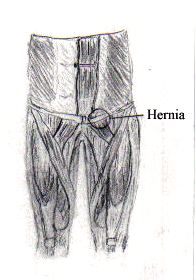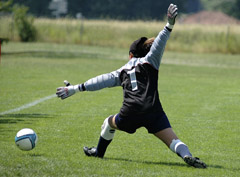|
Sports Medicine - Sports Hernia (Athletic Pubalgia) |
|
|
Many sports fans are probably wondering why athletes like Donovan McNabb of the Philadelphia Eagles (NFL- QB), Grant Hill of the Orlando Magic (NBA- SF) or Scott Walker of the Nashville Predators (NHL- RW) sat out for most of their 2005-2006 season. The reason behind this is that they have all sustained sports hernia injuries. This injury often presents in athletes as pain in the lower groin or abdominal region. (picture © Guenter Fischer. BigStockPhoto.com)
What is Sports Hernia (Athletic Pubalgia)?
 A sports
hernia or athletic pubalgia is a condition which is caused by weakness of
the abdominal wall muscles or tendons. As a result of this weakness,
athletic activities which require high speed twisting, turning, jumping,
running, and cutting can often lead to a tear where the abdominal muscles
and tendons meet the bones of the pelvis. As a result of this tear or
weakness, the contents of the abdomen pushes out. This
pressure from the contents pushing out can often result in a pinching pain
and swelling in the groin and lower abdominal region. The image provided
displays the approximate region where the sports hernia can occur. This pain
is further increased with sudden movements such as running, jumping,
kicking, going up/down stairs, sneezing or coughing. Having a strong core
and abdominal muscles can help minimize occurrence of the injury, but having
good hip flexor flexibility plays an important role in prevention as
well. A sports
hernia or athletic pubalgia is a condition which is caused by weakness of
the abdominal wall muscles or tendons. As a result of this weakness,
athletic activities which require high speed twisting, turning, jumping,
running, and cutting can often lead to a tear where the abdominal muscles
and tendons meet the bones of the pelvis. As a result of this tear or
weakness, the contents of the abdomen pushes out. This
pressure from the contents pushing out can often result in a pinching pain
and swelling in the groin and lower abdominal region. The image provided
displays the approximate region where the sports hernia can occur. This pain
is further increased with sudden movements such as running, jumping,
kicking, going up/down stairs, sneezing or coughing. Having a strong core
and abdominal muscles can help minimize occurrence of the injury, but having
good hip flexor flexibility plays an important role in prevention as
well.
Diagnosis A sports hernia can be diagnosed by a physician. There will be tenderness in the region of the groin and where the bulge is likely occurring. Tests can be performed to rule out other causes of groin & lower abdominal pain. A MRI can also be performed to identify a tear.
Treatment Conservative treatments such as rest, anti-inflammatory medications, ice and physical therapy are often tried first. However, once a sports hernia has been diagnosed surgery is the primary means of repairing this injury. Recovery after surgery can take anywhere from 4-52 weeks based on the severity of the injury and the surgical procedure performed. Rehabilitation is often required after surgery in order to return to sports.
Last revised: June 6, 2008
|
|
|
|
|






